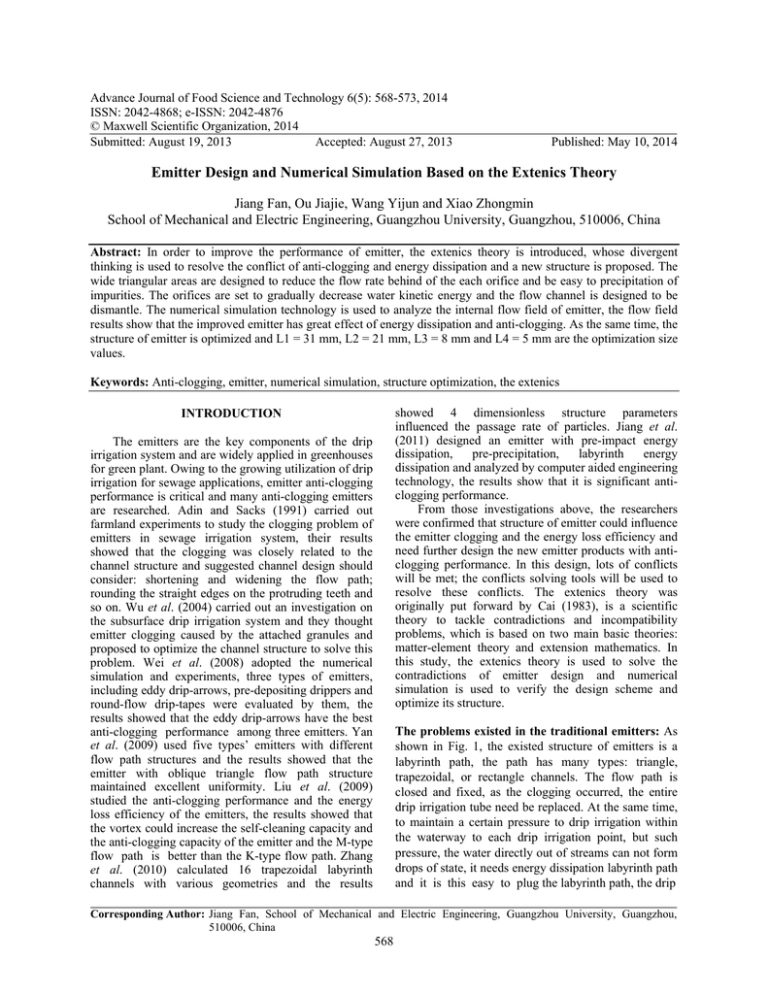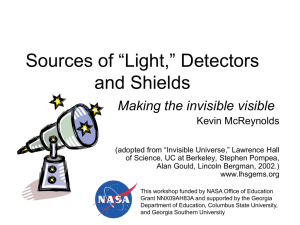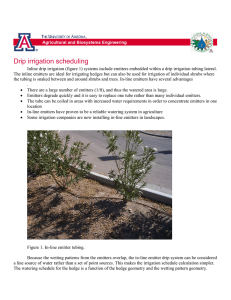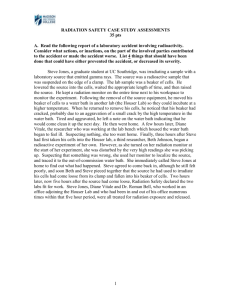Advance Journal of Food Science and Technology 6(5): 568-573, 2014
advertisement

Advance Journal of Food Science and Technology 6(5): 568-573, 2014 ISSN: 2042-4868; e-ISSN: 2042-4876 © Maxwell Scientific Organization, 2014 Submitted: August 19, 2013 Accepted: August 27, 2013 Published: May 10, 2014 Emitter Design and Numerical Simulation Based on the Extenics Theory Jiang Fan, Ou Jiajie, Wang Yijun and Xiao Zhongmin School of Mechanical and Electric Engineering, Guangzhou University, Guangzhou, 510006, China Abstract: In order to improve the performance of emitter, the extenics theory is introduced, whose divergent thinking is used to resolve the conflict of anti-clogging and energy dissipation and a new structure is proposed. The wide triangular areas are designed to reduce the flow rate behind of the each orifice and be easy to precipitation of impurities. The orifices are set to gradually decrease water kinetic energy and the flow channel is designed to be dismantle. The numerical simulation technology is used to analyze the internal flow field of emitter, the flow field results show that the improved emitter has great effect of energy dissipation and anti-clogging. As the same time, the structure of emitter is optimized and L1 = 31 mm, L2 = 21 mm, L3 = 8 mm and L4 = 5 mm are the optimization size values. Keywords: Anti-clogging, emitter, numerical simulation, structure optimization, the extenics showed 4 dimensionless structure parameters influenced the passage rate of particles. Jiang et al. (2011) designed an emitter with pre-impact energy dissipation, pre-precipitation, labyrinth energy dissipation and analyzed by computer aided engineering technology, the results show that it is significant anticlogging performance. From those investigations above, the researchers were confirmed that structure of emitter could influence the emitter clogging and the energy loss efficiency and need further design the new emitter products with anticlogging performance. In this design, lots of conflicts will be met; the conflicts solving tools will be used to resolve these conflicts. The extenics theory was originally put forward by Cai (1983), is a scientific theory to tackle contradictions and incompatibility problems, which is based on two main basic theories: matter-element theory and extension mathematics. In this study, the extenics theory is used to solve the contradictions of emitter design and numerical simulation is used to verify the design scheme and optimize its structure. INTRODUCTION The emitters are the key components of the drip irrigation system and are widely applied in greenhouses for green plant. Owing to the growing utilization of drip irrigation for sewage applications, emitter anti-clogging performance is critical and many anti-clogging emitters are researched. Adin and Sacks (1991) carried out farmland experiments to study the clogging problem of emitters in sewage irrigation system, their results showed that the clogging was closely related to the channel structure and suggested channel design should consider: shortening and widening the flow path; rounding the straight edges on the protruding teeth and so on. Wu et al. (2004) carried out an investigation on the subsurface drip irrigation system and they thought emitter clogging caused by the attached granules and proposed to optimize the channel structure to solve this problem. Wei et al. (2008) adopted the numerical simulation and experiments, three types of emitters, including eddy drip-arrows, pre-depositing drippers and round-flow drip-tapes were evaluated by them, the results showed that the eddy drip-arrows have the best anti-clogging performance among three emitters. Yan et al. (2009) used five types’ emitters with different flow path structures and the results showed that the emitter with oblique triangle flow path structure maintained excellent uniformity. Liu et al. (2009) studied the anti-clogging performance and the energy loss efficiency of the emitters, the results showed that the vortex could increase the self-cleaning capacity and the anti-clogging capacity of the emitter and the M-type flow path is better than the K-type flow path. Zhang et al. (2010) calculated 16 trapezoidal labyrinth channels with various geometries and the results The problems existed in the traditional emitters: As shown in Fig. 1, the existed structure of emitters is a labyrinth path, the path has many types: triangle, trapezoidal, or rectangle channels. The flow path is closed and fixed, as the clogging occurred, the entire drip irrigation tube need be replaced. At the same time, to maintain a certain pressure to drip irrigation within the waterway to each drip irrigation point, but such pressure, the water directly out of streams can not form drops of state, it needs energy dissipation labyrinth path and it is this easy to plug the labyrinth path, the drip Corresponding Author: Jiang Fan, School of Mechanical and Electric Engineering, Guangzhou University, Guangzhou, 510006, China 568 Adv. J. Food Sci. Technol., 6(5): 568-573, 2014 Wall Base _ tubes M1 Diameter Thickness Dripper M 2 R M2 Fig. 2: Element representation of emitter based on semantic network Set buckle to easy disassemble Rigid wall instead elastic wall Set slot installed drippers M1 Set the seal groove on the outer wall Design the sealing cover Structure design positioning Design of edge seal structure to the flow channel Setting buckle for easy disassemble M2 Flow channel improvements for energy dissipation Disassembly Anti _ blocking _ property Structure Subject M1 Emitter R Object M2 Connection embedded Fig. 1: The exited structure of emitter M1 Elastic 20mm 1.0mm Structure design of positioning Fig. 3: Improvement ideas based on divergent thinking irrigation faced the contradiction between the energy dissipation (head loss) of flow channel and clogging. The solving idea of the conflicts based on the extenics theory: Element representation based semantic network: Appling the extenics theory, the structures of emitter should be described as information element. In extenics theory, there are four kinds of information element and the semantic network is important knowledge representation, which it could represent the structure, characteristics and connect. The element representations of the emitter based on the semantic network are described in the following: fixed average sheet (1) (2) (3) The drip irrigation system includes a base pipe and dripper and is described by use of matter-element M1 and M2. From the Eq. (1) and (2), the matter-element M1 includes the characteristic of wall, diameter, thickness and their values. The matter-element M2 involves the characteristic of disassembly, antiblocking-property, structure and their values. The contact between M1 and M2 is the relational element R, which has property of subject, object, connection and their values. The extension semantic network of drip irrigation system is established and shown in Fig. 2. Extenics rhombus thinking: Improvement ideas based on divergent thinking of base tube: rigid wall instead elastic wall, set slot installed drippers, set the seal groove on the outer wall, set buckle to easy disassemble, design the sealing cover, design positioning structure. Improvement ideas based on divergent thinking of the dripper: setting buckle for easy disassemble, flow channel improvements for energy dissipation, design of edge seal structure to the flow channel, design of positioning structure (Fig. 3). Improvement ideas based on divergent thinking of connected relationship: connection with drop-in easy to dismantle structure, connection with pressure tightly, connection with plug-in easy to dismantle structure, structure design of connection positioning. According to the idea of divergent thinking, the drip irrigation system (or emitter) is improved and shown in Fig. 4: 569 In order to prevent clogging, a wide triangular areas is designed behind of the each orifice, which can drastically reduce the flow rate and be easy to precipitation of impurities. For energy dissipation, the throttling grooves are set, whose sizes are gradually decreased. In order to facilitate disassembly and replacement, the flow channel is designed to be dismantle, groove is provided for install the flow channel Adv. J. Food Sci. Technol., 6(5): 568-573, 2014 Dynamics (CFD) technology is used to optimize parameters of its flow and structure, these results could provide a reference for its size selection and emitter operation. Flow analysis is as follows (Jiang et al., 2009, 2011). The flow in emitter observes the mass conservation, the conservation of momentum and uses the standard k-ε turbulence condition to close the equations, simulation control equations are shown in Eq. (4)-(7): m m m m ui 0 t xi (4) m mui m p u mu j 2 mui [m ( m i ij )] (mm ui' u'j ) 0 t xi xi x j xi x j x j 3 Fig. 4: Improved structure of drip irrigation tube (5) k m k [( m t ,m ) m ] Gk Gb m 0 t xi k xi (6) m 2 [( m t , m ) m ] C1 (Gk C3 Gb ) C2 m m 0 t xi k xi (7) Fig. 5: The model of calculation zone Fig. 6: The structure size of calculation zone where, = αm ρm = xi = ui = p = μm = ′ = k = Gk = Gb = μt,m , = = = mth phase volume fraction mth phase density Coordinate component in i direction Velocity of i direction Pressure mth phase viscosity Velocity pulsating quantity Turbulence kinetic energy The generation of turbulence kinetic energy due to the mean velocity gradients The generation of turbulence kinetic energy due to buoyancy Rate of dissipation of turbulence kinetic energy mth phase turbulent viscosity The turbulent Prandtl numbers for k and The constants of Eq. (6) and (7) are: C1 1.44 , C2 1.92 , C 0.09 , k 1.0 , 1.3 Fig. 7: The mesh model outside of emitter wall and the around seal and positioning buckle are designed, the cover is connected by the buckle. Numerical simulation of emitter: Found in the design of drip irrigation tube, flow parameters and the structure parameters of emitter are key factors to impact its anti-blocking properties, Computational Fluid The internal flow structure of drip irrigation tube is shown in Fig. 5, inlet diameter is 1.5 mm, outlet diameter is 1 mm, the initial structures for energy dissipation are: L1 = 30 mm, L2 = 20 mm, L3 = 9 mm, L4 = 4 mm, these sizes locations are shown in Fig. 6. The geometric model is meshed by tetrahedral cell, is shown in Fig. 7, a total of 105657 cells, 26848 nodes. The multiphase flow model is Eulerian model, the turbulence model is k-ε model and the separation solve of steady state is chosen. The primary phase is water, its density is 998.2 kg/m3 and viscosity is 570 Adv. J. Food Sci. Technol., 6(5): 568-573, 2014 (a) Pressure (b) Velocity (c) Water phase (d) Streamline Fig. 8: The results of initial structure 571 Adv. J. Food Sci. Technol., 6(5): 568-573, 2014 65500 0.062 66000 63000 0.056 0.054 ︶ 64500 0.058 64000 0.056 63500 ︵ ︶ 62000 0.060 e c n e r e f f i d e r u s s e r P ︵ 0.058 a P m ︶ ︵ 64000 65000 m 65000 ︵ ︶ e c n e r e f f i d e r u s s e r P e c n a t s i d t n e m i d e s d n a S a P 0.060 e c n a t s i d t n e m i d e s d n a S 0.062 0.064 e c n a t s i d t n e m i d e s d n a S e c n a t s i d t n e m i d e s d n a S 66000 e c n e r e f f i d e r u s s e r P e c n e r e f f i d e r u s s e r P 0.064 67000 61000 0.054 63000 0.052 60000 62500 32 0.052 L2 18 ︶ ︵ (a) Influence of L1 22 ︶ (b) Influence of L2 e c n e r e f f i d e r u s s e r P e c n a t s i d t n e m i d e s d n a S 64200 20 m m ︵ 30 m m L1 28 Pressure difference Sand sediment distance 64800 0.064 64600 0.070 0.068 64000 0.062 64400 ︶ 63400 0.058 63200 0.056 63000 m ︵ e c n a t s i d t n e m i d e s d n a S 0.060 63600 ︵ ︶ e c n e r e f f i d e r u s s e r P 62800 0.054 62600 64200 0.064 64000 0.062 63800 0.060 63600 0.058 63400 0.056 63200 0.054 63000 0.052 0.050 62800 ︵ m m L3 8 10 2 ︶ Sand sediment distance (m) 63800 Pressure difference (Pa) 0.066 a P 4 6 L4 (mm) (c) Influence of L3 (d) Influence of L4 Fig. 9: The optimization results Table 1: The parameters of calculation models Models No. L1 L2 L3 L4 1 28 20 9 4 2 29 20 9 4 3 30 20 9 4 4 30 19 9 4 5 30 20 8 4 6 30 20 9 2 7 30 20 9 3 8 30 20 9 5 9 30 20 9 6 10 30 20 10 4 11 30 20 8.5 4 12 30 20 9.5 4 13 30 21 9 4 14 30 19.5 9 4 15 30 20.5 9 4 16 31 20 9 4 17 32 20 9 4 Cells 80864 93076 105657 119703 94396 102175 104891 105473 107355 117465 100563 111972 92483 113016 99260 120867 135814 Nodes 20631 23693 26848 30284 24042 26000 26653 26817 27280 29820 25552 28424 23624 28640 25270 30597 34362 0.001003 kg/m.sec; the secondary phase is sand, its density is 2650 kg/m3 and viscosity is 0.1 kg/m.sec. The inlet boundary is pressure inlet and its total pressure is 98066.1 Pa, the turbulent intensity is 5% and the hydraulic diameter is 0.0015 m, the volume fraction of sand is 0.12. The outlet boundary is pressure outlet, its pressure is 0 Pa. The spatial discretization of momentum, the volume fraction, turbulent kinetic energy and the turbulent dissipation rate is first order upwind. The computation results are shown in Fig. 8. From Fig. 8, the pressure inside of emitter reduces gradually, which reduces to 724.9 Pa from 98066.1 Pa and indicates the effect of energy dissipation is significant. The velocity of flow increases, from 3.78 to 9.5 m/sec. The sand could quickly precipitate before they enter the third triangle buffer. The streamline result shows that the flow inside of emitter is regular, so that the sand is not disturbed by follow flow and ensure the outlet is not blocked. Structure optimization of emitter: As shown in Fig. 6, the size parameters of L1, L2, L3 and L4 are varied, there are 17 models been established and the parameters are shown in Table 1. Using the pressure difference (head loss) and the distance of the sand sedimentation as the evaluation index, four parameters of L1, L2, L3 and L4 impact to the dissipation and anti-clogging are discussed and the results are shown in Fig. 9. 572 Adv. J. Food Sci. Technol., 6(5): 568-573, 2014 According to Fig. 9a, along with size L1 increased from 28 to 32 mm, the pressure difference always dropped, but the sand sediment distance increased and then dropped. There is a clear that L1 = 31 mm could execute great effect of energy dissipation and anticlogging. From Fig. 9b, as L2 increased, the pressure difference increased too, which rose slowly at beginning and then rose sharply. The variation of sand sediment distance is similar to Fig. 9a. It would seem that the size L2 = 21 mm is suitable. As shown in Fig. 9c, increasing the size L3 led to the pressure difference decreased and the variation of sand sediment distance kept analogous trend. Results in this diagram, the size L3 = 8 is the best. Figure 9d shows, as the size L4 = 3, the pressure difference has been found the max is 64599.69 Pa and the sand sediment distance is miniature with 52.3 mm, so the L4 = 5 mm is recommended value. Overall, the optimization values of these sizes are: L1 = 31 mm, L2 = 21 mm, L3 = 8 mm and L4 = 5 and using these optimization sizes, a new model is established and calculated, the pressure difference is 68172.242 Pa and the sand sediment distance is 50.2 mm, these results ensure that the emitter would have good performance of anti-clogging and energy dissipation. CONCLUSION According to the idea of extenics theory, the emitter is improved, the wide triangular areas are designed behind of the each orifice, which can drastically reduce the flow rate and be easy to precipitation of impurities; the orifices are set, whose diameter are gradually decreased; the flow channel is designed to be dismantle. The internal flow field of emitter is analyzed, the flow field results show that this emitter has great effect of energy dissipation and anti-clogging. The structure of emitter is optimized and as L1 = 31 mm, L2 = 21 mm, L3 = 8 mm and L4 = 5, the emitter has the best performance. ACKNOWLEDGMENT This research was supported by the Science and Technology Plan Project of Guangdong Province (2012B061000013), Popular Science Project of Guangzhou (2013KP042) and Open Fund of Key Laboratory of Innovation Method and Decision Management System of Guangdong Province (2011A060901001-19D). REFERENCES Adin, A. and M. Sacks, 1991. Dripper clogging factors in waste water irrigation. J. Irrig. Drain. E-ASCE, 117: 813-826. Cai, W., 1983. Extension set and non-compatible problems [J]. J. Sci. Explor., 1: 83-97. Jiang, F., C.M. Huang and Z.W. Liang, 2009. Numerical simulation of rotating-cage bio-reactor based on dynamic mesh coupled two-phase flow. Proceeding of the 2nd International Conference on High Performance Computing and Applications (ICHPCA, 2009), pp: 206-211. Jiang, F., C.M. Huang, J.H. Xiang and Y.J. Wang, 2011. Design and optimization of drip irrigation emitters using directly of sewage. Proceeding of the 6th International Conference on Computer Science and Education (ICCSE, 2011), pp: 483- 488. Liu, H.S., Y.K. Li, Y.Z. Liu, P.L. Yang, S.M. Ren, R.J. Wei and H.B. Xu, 2009. Flow characteristics in energy dissipation units of labyrinth path in the drip irrigation emitters with DPIV technology. J. Hydrodynam., 21(6): 137-145. Wei, Q.S., G. Lu, J. Liu, Y.S. Shi, W.C. Dong and S.H. Huang, 2008. Evaluations of emitter clogging in drip irrigation by two-phase flow simulations and laboratory experiments. Comput. Electron. Agr., 63: 294-303. Wu, F., Y.S. Fan, H. Li, Z.X. Guo, J.S. Li and W.C. Li, 2004. Clogging of emitter in subsurface drip irrigation system. T. CSAE, 20: 80-83. Yan, D., Z.H. Bai, R. Mike, L.K. Gu, S.M. Ren and P.L. Yang, 2009. Biofilm structure and its influence on clogging in drip irrigation emitters distributing reclaimed wastewater. J. Environ. Sci., 21: 834-841. Zhang, J., W.H. Zhao, Y.P. Tang and B.H. Lu, 2010. Anti-clogging performance evaluation and parameterized design of emitters with labyrinth channels. Comput. Electron. Agr., 74: 59-65. 573







